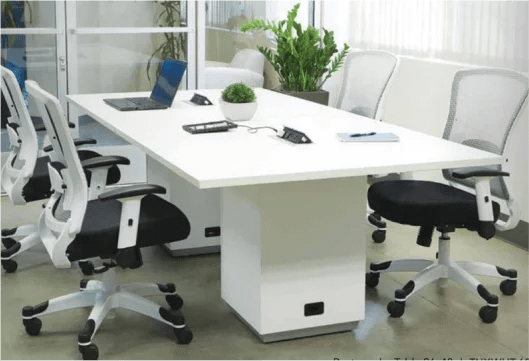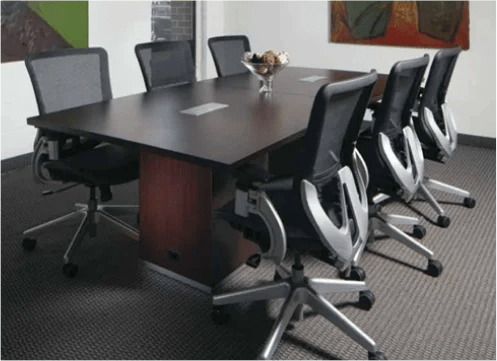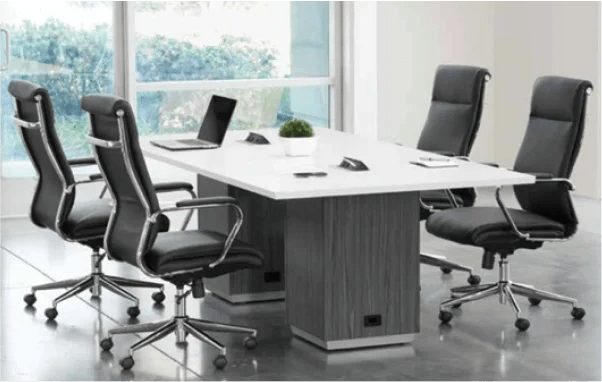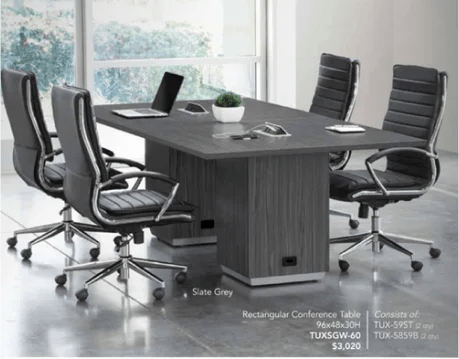- NY Phone: (212) 641-4300 |
- NJ Phone: (908) 300-5664
How to Extend the Life of Office Furniture With Refurbishing
How to Extend the Life of Office Furniture With Refurbishing

Office furniture is a significant investment, and with proper care, it can serve your workspace efficiently for years to come. Instead of prematurely replacing worn-out desks, chairs, and cabinets, consider the cost-effective and sustainable solution of refurbishing them. This comprehensive guide will walk you through key refurbishing techniques to extend the life of your office furniture while maintaining a professional and polished look.
The Foundation of Longevity: Regular Cleaning
A consistent cleaning routine is the cornerstone of maintaining the integrity of your office furniture. Different materials require specific cleaning approaches:
- Wood: Utilize a dedicated wood cleaner, avoiding harsh chemicals that can damage the finish. Be sure to blot spills immediately to prevent absorption.
- Laminate: A mild soap and water solution is generally the most effective. Avoid abrasive pads that could inadvertently scratch the surface.
- Upholstery: Regular vacuuming is crucial for preventing dust buildup. For stains, use a fabric-specific cleaner according to the manufacturer’s instructions.
- Metal: Wipe with a damp cloth and a mild detergent. Avoid abrasive cleaners that could lead to scratching.
- Leather: Apply a high-quality leather conditioner regularly to maintain its softness and prevent cracking. Protect leather furniture from direct sunlight to minimize fading.
Addressing Issues Early: Repairing Damage
Small damages, if left unaddressed, can escalate over time. Prompt repairs are essential for maintaining both the functionality and aesthetics of your furniture.
- Loose Joints: Apply wood glue to the joint and secure it with clamps until it dries completely. For added durability, consider reinforcing with dowels or screws.
- Scratches and Dents: Use furniture touch-up markers for minor scratches. For deeper dents, fill them with wood filler, sand the area smooth once dry, and then refinish.
- Upholstery Tears: Small tears can often be hand-stitched. Larger tears may necessitate patching with a matching fabric.
- Broken Hardware: Replace worn-out or broken knobs, handles, or drawer pulls to instantly refresh the look and functionality.
Giving Wood Furniture a Facelift: Refinishing
A worn or dated wood finish doesn’t mean your furniture is beyond repair. Refinishing can bring it back to its former glory:
- Sanding: Begin with coarse-grit sandpaper and progressively use finer grits to achieve a smooth surface.
- Staining (Optional): If you desire a change in the wood’s color, apply a wood stain, carefully following the manufacturer’s instructions.
- Finishing: Choose a protective finish based on the required durability and desired look. Options include varnish, lacquer, polyurethane, or wax.
- Sanding Between Coats: Lightly sanding between coats of finish ensures a smooth and even final appearance.
Reviving Worn Surfaces: Applying New Laminate
For desks and other furniture with peeling or damaged laminate, applying a new layer can dramatically restore their appearance:
- Surface Preparation: Remove the old laminate if necessary and thoroughly clean the underlying surface.
- Cutting and Bonding: Accurately cut the new laminate to the required size, apply contact cement to both surfaces, and firmly press the laminate into place.
- Trimming: Use a router or laminate trimmer to achieve precise and clean edges.
Transforming Your Seating: Reupholstering Chairs
Updating the upholstery on your office chairs can completely transform their appearance and comfort:
- Removing Old Fabric: Carefully remove the existing upholstery, taking note of how it was attached.
- Cutting New Fabric: Use the old fabric as a template to cut the new fabric to the correct size and shape.
- Stapling: Pull the new fabric taut and secure it to the frame with a staple gun, ensuring a smooth and wrinkle-free finish.
- Finishing Touches: Neatly fold and tuck corners for a professional appearance before reattaching the seat and back to the chair frame.
Adding a Polished Edge: Edge Banding
Applying edge banding to furniture not only protects it from wear and tear but also creates a more refined and finished look:
- Iron-On Edge Banding: Use a standard iron to securely adhere the banding to the edges.
- Self-Adhesive Banding: This option offers a quick and easy way to update edges – simply peel and apply.
- PVC Banding: Requires specialized adhesives and tools for proper application and a durable finish.
A Quick Update: Hardware Updates
One of the simplest and most impactful ways to modernize your office furniture is by updating the hardware. Choose new handles, knobs, and drawer pulls that complement your office’s aesthetic. Simply unscrew the old hardware and replace it with the new for an instant transformation.
Adding Character and Charm: Distressing Techniques
For a more rustic, vintage, or unique aesthetic, consider incorporating distressing techniques to enhance the appearance of your furniture:
- Sanding: Lightly sand corners and edges to create a worn and aged effect.
- Dry Brushing: Use a minimal amount of paint on a dry brush to create a weathered appearance.
- Crackle Finish: Apply a crackle medium before painting to achieve a naturally aged, cracked look.
- Antiquing Glaze: Apply an antiquing glaze and then wipe away the excess to add depth and character to the piece.
Protecting Your Investment: The Final Finish
<Once your furniture is refinished or refurbished, protecting it is crucial for ensuring its longevity:
- Varnish: Offers a durable and water-resistant protective layer.
- Lacquer: Provides a fast-drying, high-gloss finish.
- Polyurethane: Known for its scratch resistance and high durability.
- Wax: Offers a natural, soft finish that can provide some protection.
Apply your chosen sealant in thin, even coats, allowing each layer to dry completely before applying the next
Key Takeaways for Office Furniture Refurbishing:
<Once your furniture is refinished or refurbished, protecting it is crucial for ensuring its longevity:
- Prevention is Key: Regular maintenance and cleaning are essential to prevent major damage.
- Act Promptly: Address any damage as soon as it becomes apparent to prevent it from worsening.
- Utilize Quality Materials: Investing in good tools and supplies will ensure more lasting and professional results.
- Patience is a Virtue: Refurbishing is a process, but the satisfaction and cost savings are well worth the effort.
- Embrace Experimentation: Don’t be afraid to try different finishes and techniques to achieve your desired look.
By following these steps, businesses can significantly extend the lifespan of their office furniture, leading to substantial cost savings and a more sustainable approach. At Eltru, we specialize in refurbishing and repurposing office furniture, delivering high-quality results while minimizing environmental impact.
Revamping your office furniture not only saves money but also contributes to a greener future. Take the first step towards a more sustainable and stylish workspace by embarking on your office furniture refurbishing journey today!
Contact Us For
OFFICE SPACE SOLUTIONS
and FF&E Services
Copyright © 2025 RJV Office Furnishing LLC















